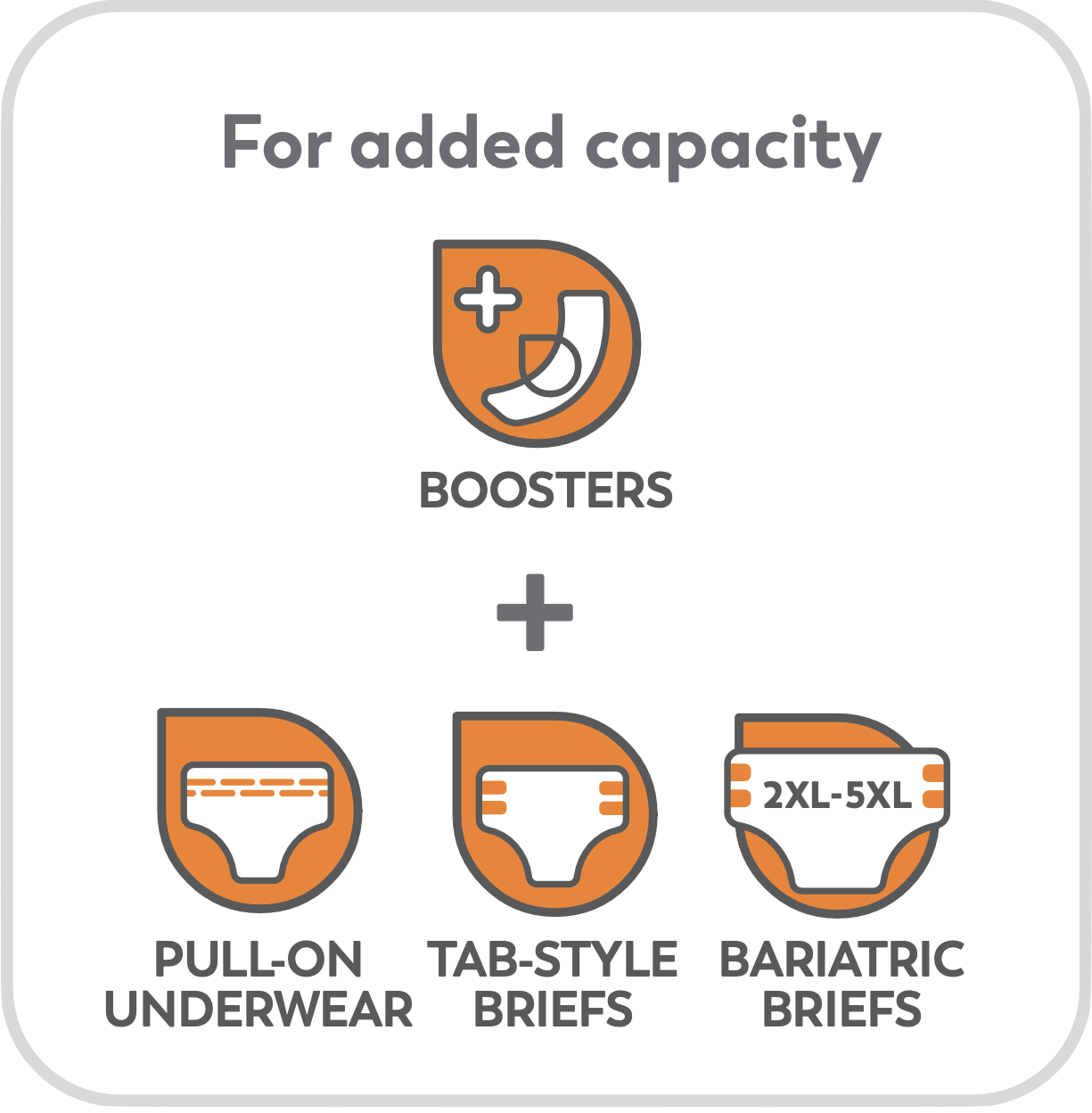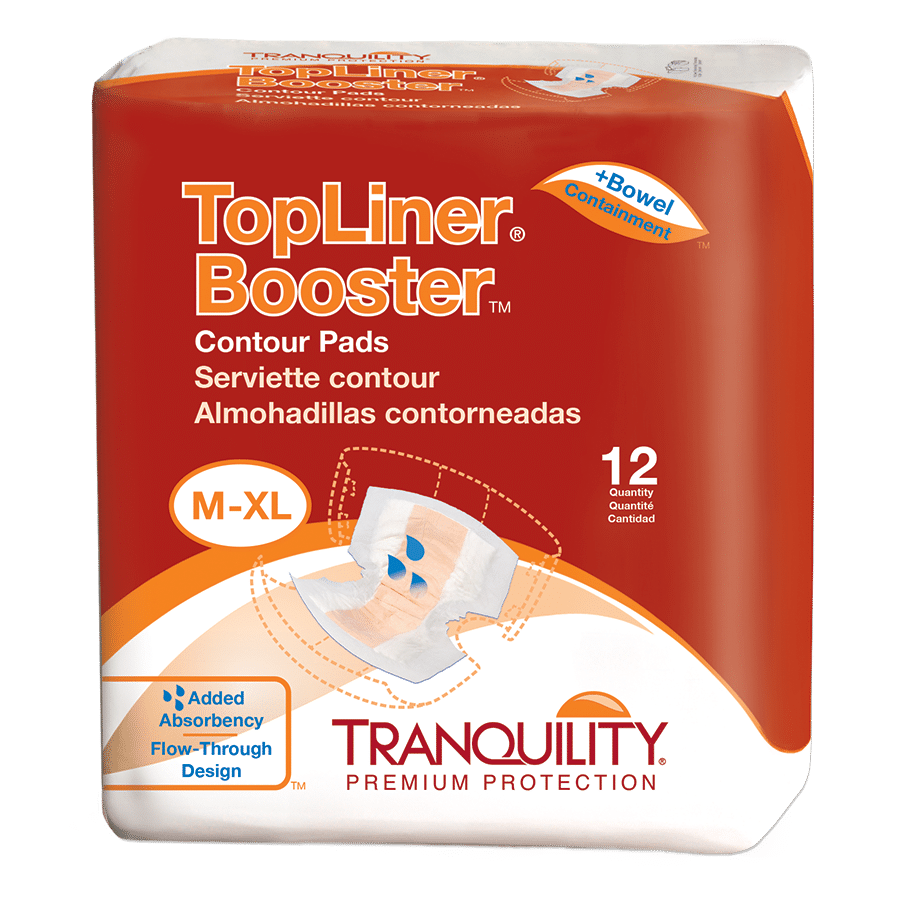With so many incontinence product options available to help manage multiple types of urinary or bowel incontinence, it’s no wonder that many people have questions about which products are appropriate for their unique situation. While many products are appropriate for both urinary incontinence and bowel incontinence (also referred to as fecal incontinence), there are more recommended solutions depending on the severity of the incontinence and that person’s individual preferences.
For example, a person experiencing severe bowel incontinence may ask, “Are incontinence pads right for me?” The short answer is – Yes, but only a specific type and size of incontinence pad product, known as a booster pad, may be helpful in managing fecal incontinence, and only if used in combination with additional bowel incontinence products. However, if used by itself or used with the wrong bowel incontinence products, using a booster pad to manage bowel incontinence could lead to accidents and potentially damage one’s skin.
We will dig into this topic further in this article, and also look at what other types of incontinence products may be more appropriate for managing fecal incontinence.
Types of Incontinence
Urinary incontinence, which can involve light to severe involuntary bladder leakage, is the most common form of incontinence. There are six types of urinary incontinence: stress, urge, overflow, reflex, functional and mixed.
Incontinence is often a symptom of another issue, including disease, medical condition, traumatic injury, muscle damage, nerve damage or other change to the body. Accidental leakage is not a normal part of aging, but can be caused by age-related changes, such as weakening of the pelvic floor muscles that are involved in the process of urination.
Fecal incontinence involves involuntary passing of liquid or solid stool, ranging from light bowel leakage to severe bowel movements. Bowel leakage is harder to contain than urinary leakage, since it is not as easily absorbed into incontinence products.
Additionally, liquid stool can be even more damaging than urine when trapped against the skin and not properly absorbed. Stool is highly caustic and can cause severe skin damage, rash or infection much more quickly than urine.
People who experience both urinary and fecal incontinence are diagnosed with “dual incontinence.”
What is an incontinence pad?
There are several types of incontinence pads. The most common of these are booster pads and personal care pads. Here are some specific and very important differences between these two products that you should know.
Personal care pads – These are also known as guards or liners, and are similar to feminine hygiene pads, menstrual pads or period pads, but are specifically made to absorb urine. They have a waterproof liner on the outside layer to keep urine and moisture from passing through, so they can be worn inside of regular cotton underwear.
Personal care pads come in a large array of shapes and sizes, and some types are even gender-specific, with contoured shapes designed to better fit male or female bodies.

The idea behind a booster pad is that it provides supplementary absorptive capacity versus wearing a disposable brief or protective underwear alone. This may be useful, for instance, if you are planning to go on a long walk or you are traveling, and a restroom may not be easily accessible. The booster pad helps extend the wear time of disposable underwear and other incontinence products to give you peace of mind.
Booster pads are highly flexible and can be folded or even doubled-up for even greater absorptive capacity (but they should never be cut). It’s important to note that booster pad placement is critical. Boosters are typically attached to disposable undergarments by an adhesive strip. The booster pad must be tucked securely inside a host garment; if part of the booster pad is sticking outside the host garment’s absorbent area, it could cause more leaks, around the leg or another area.
One last note on incontinence pads: Underpads (also known as bed pads) are technically another type of incontinence pad; however, because they are not worn on the body, we will not be discussing underpads in this article. To learn more about the different varieties of absorbent pads, including underpads, we suggest reading the blog “The Most Popular Types of Pads for Urinary Incontinence and Their Benefits.”
Fecal continence management with a special booster pad product
As we just discussed, personal care pads and booster pads possess the absorption required of a urinary care product, but are typically smaller in size so that they be worn discreetly, inside of other garments. Due to this smaller size, incontinence pads typically hold a reduced amount of waste and are designed instead to protect against light to moderate urinary incontinence; they generally lack the coverage needed to contain a bowel movement.
However, there is one pad product designed by Tranquility that can help protect equally well from both urinary and fecal incontinence.

If bowel incontinence episodes occur alongside urinary episodes, Tranquility Contour Booster Pads may be a solution. Contour Booster Pads absorb urine but due to their wide hourglass shape, they are also effective at helping to control bowel leakage from fecal incontinence.
These highly absorbent products come in two size options:
- Contour Size – 21.5″ x 13.5″ with a capacity to hold up to 13.6 oz. Suited to be worn inside of Medium to Extra-Large host garments.
- Super-Plus Size – 32″ x 14″ and holds up to 27.5 oz. Suited to be worn inside of 2XL-5XL bariatric garments.
Because of their full-fit design, these item works best with tape-tab briefs.
Contour Booster Pads may even be removed and properly disposed after light bowel movements, so the wearer can continue to wear the unsoiled host garment, saving time and hassle (and saving money on products due to fewer changes).
Other suggested bowel incontinence products
Here are a few additional, highly recommended products to help manage bowel incontinence.
A heavy-protection, tape-tab disposable brief, like Tranquility® SmartCore® Briefs, or a high-capacity pull-on disposable underwear, like Tranquility Premium OverNight™ Underwear, are best to help manage fecal incontinence.
Both of these bowel incontinence products offer wearers the benefit of soft, clothlike materials for gentle comfort, as well as soft leg elastics and inner Kufguards® that create a secure fit and help contain bowel leakage. Premium OverNight Underwear offer the additional feature of 100% breathable materials that allow moist, warm air to escape and allow fresh air to cycle into the garment, helping to keep skin dry and healthy.
As previously discussed, the harmful effects of loose stool leakage on skin for prolonged periods of time make it crucial to change bowel incontinence products in a timely manner after a bowel movement. There are products to assist with bowel incontinence care, such as Tranquility Cleansing Wipes and Tranquility ThinLiner™ Moisture Management Sheets.
Tranquility cleansing wipes are hypoallergenic and latex-free. With a generous 9″ x 13″ size, these wipes are designed to assist in getting a quick and complete clean-up after a loss of bowel control, while keeping skin hydrated. Tranquility cleansing wipes are paraben- and alcohol-free and enriched with aloe vera, chamomile and vitamin E to avoid leaving users with dry or irritated skin.
ThinLiner Sheets are a unique product that can be folded and placed inside of disposable products to help collect stool. They come in multiple size and capacity options from the 6″ x 10″ cloth with a 6-oz capacity to the 6″ x 14″ option with an 8.5-oz absorption capacity. ThinLiner Sheets should always be placed inside another disposable fecal incontinence product that has a moisture-proof backing; do not use with regular underwear.
Learn more about products used to manage fecal incontinence by reading our “Best Bowel Incontinence Products” blog.
Where Can I Buy Bowel Incontinence Products?
You can buy bowel incontinence products from Tranquility’s authorized online partners, use the Tranquility store locator to find bowel incontinence products at a store near you or call our Customer Care Team at 1-866-865-6101.
For additional information
If you need help selecting the right fecal incontinence products for your needs, please call a friendly Tranquility Care Center representative at 1-866-865-6101, Monday-Friday, 8 a.m.-5 p.m. EST or email CustomerService@pbenet.com. You can also check out Tranquility’s full range of fecal incontinence options at www.TranquilityProducts.com.
If you have just begun to experience fecal incontinence or anal discomfort, you should talk with a continence professional who may be able to recommend surgery, treatment or other forms of management that can help, like kegel exercises, pelvic floor exercises or bowel training activities.